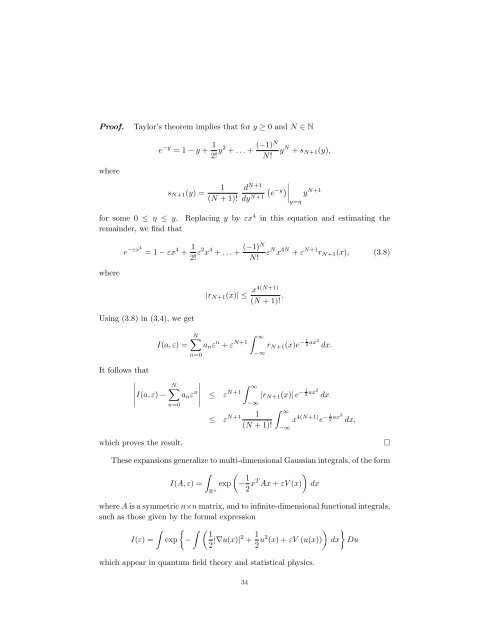Asymptotic Analysis and Singular Perturbation Theory
Asymptotic Analysis and Singular Perturbation Theory
Asymptotic Analysis and Singular Perturbation Theory
You also want an ePaper? Increase the reach of your titles
YUMPU automatically turns print PDFs into web optimized ePapers that Google loves.
Proof. Taylor’s theorem implies that for y ≥ 0 <strong>and</strong> N ∈ N<br />
where<br />
e −y = 1 − y + 1<br />
2! y2 + . . . + (−1)N<br />
N! yN + sN+1(y),<br />
sN+1(y) =<br />
1<br />
(N + 1)!<br />
dN+1 dyN+1 −y<br />
e y=η y N+1<br />
for some 0 ≤ η ≤ y. Replacing y by εx 4 in this equation <strong>and</strong> estimating the<br />
remainder, we find that<br />
where<br />
e −εx4<br />
= 1 − εx 4 + 1<br />
2! ε2 x 4 + . . . + (−1)N<br />
N! εN x 4N + ε N+1 rN+1(x), (3.8)<br />
Using (3.8) in (3.4), we get<br />
I(a, ε) =<br />
N<br />
n=0<br />
It follows that<br />
<br />
<br />
N<br />
<br />
I(a,<br />
ε) − anε<br />
n<br />
<br />
<br />
<br />
<br />
<br />
n=0<br />
|rN+1(x)| ≤ x4(N+1)<br />
(N + 1)! .<br />
anε n + ε N+1<br />
∞<br />
≤ εN+1<br />
∞<br />
−∞<br />
−∞<br />
≤ ε N+1 1<br />
(N + 1)!<br />
1 −<br />
rN+1(x)e 2 ax2<br />
dx.<br />
1 −<br />
|rN+1(x)| e 2 ax2<br />
dx<br />
∞<br />
−∞<br />
x 4(N+1) 1 −<br />
e 2 ax2<br />
dx,<br />
which proves the result. <br />
These expansions generalize to multi-dimensional Gaussian integrals, of the form<br />
<br />
I(A, ε) = exp − 1<br />
2 xT <br />
Ax + εV (x) dx<br />
R n<br />
where A is a symmetric n×n matrix, <strong>and</strong> to infinite-dimensional functional integrals,<br />
such as those given by the formal expression<br />
<br />
1<br />
I(ε) = exp −<br />
2 |∇u(x)|2 + 1<br />
2 u2 <br />
(x) + εV (u(x)) dx Du<br />
which appear in quantum field theory <strong>and</strong> statistical physics.<br />
34
















